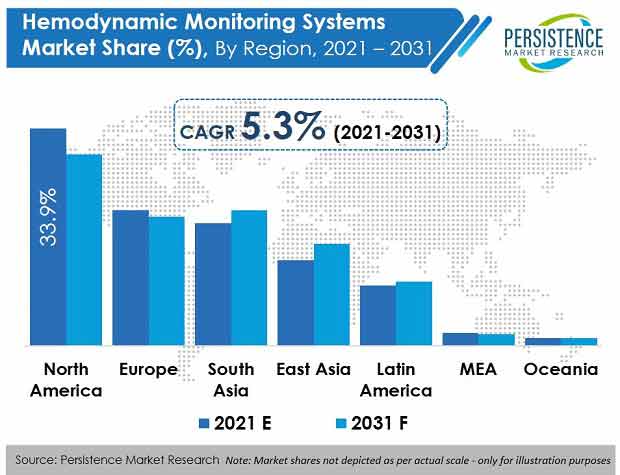Hemodynamic Monitoring Systems Market 2022
The global hemodynamic monitoring systems market is worth US$ 1.35 Bn at present, and is set to expand 1.7X over the next ten years. The market is expected to reach US$ 2.4 Bn by the end of 2031, with sales revenue expected to register 5.3% CAGR.
Get Free Sample Copy of this Report@ https://www.persistencemarketresearch.com/samples/32933
Cardiovascular diseases such as congestive heart failure are usually long-term and cost-incurring conditions. Incidence of cardiac disorders accounts for over 32 percent of all deaths worldwide, as per WHO. Lifestyle-related diseases and ageing population function as two primary drivers for cardiovascular diseases globally.
With repeated assessment of circulatory function over time, perturbations with regards to physiological stress such as tissue hypoxia associated with surgery can be easily monitored and prevent cases of morbidity or mortality. This factor justifiably drives demand for hemodynamic monitoring systems, and is followed by repeated and advanced technological modifications to pre-existing monitoring systems.
Growth of hemodynamic monitoring systems is supported by rising health expenditure by governments as well as private players, especially in developed economies. Growth is set to lead to management of cardiac output with minimal continuous observation and a patient- and physician-adaptable interface to provide feedback and alerts predicting hemodynamic instability.
Although the market has witnessed advancement of technology in terms of hemodynamic monitoring, lack of trained professionals for operation of instruments poses a restrictive factor for market growth.
Opportunistic growth awaits throughout the forecast period in terms of new developments in non-invasive hemodynamic monitoring. Apart from this, emergence of implants for hemodynamic monitoring are expected to enhance the adoption of remote monitoring in personal and homecare settings. Increasing patient population in emerging economies is expected to drive demand for hemodynamic monitoring systems over the forecast period.
Considering consolation activities in the global market, mergers and acquisitions have emerged as one of the key growth strategies by market players. Prominent players are strengthening their product ranges through acquisitions and reaching out to key as well as emerging markets.
Company Profiles:
Edwards Lifesciences Corporation, General Electric Company, Tensys medical, Cheetah medical Inc., Medical ICU, Royal Philips NV, LiDCo Group, Osypka Medical GmbH, Schwarzer Cardiotek GmbH, Getinge AB, Medtronic Plc., Abbott Laboratories, Deltex medical group, Bistos Co.Ltd, Uscom, NI Medical, About Nihon
Request For Customization@https://www.persistencemarketresearch.com/request-customization/4396

For instance:
- In September 2021, ICU Medical, Inc. and Smiths Group plc announced that ICU Medical has committed to acquire Smiths Medical division in a transaction that is more than the existing proposed sale of Smiths Medical to Trulli Bidco Limited.
Key Takeaways from Market Study
- By type, non-invasive hemodynamic monitoring systems are expected to hold over 52% market value share by the end of 2031.
- Based on product, hemodynamic monitors are leading with 63.8% market share in 2020, owing to advancements in digitally integrated health solutions devices.
- Based on modality, portable hemodynamic monitors are leading with 54.3% market share, due to high prevalence of cardiovascular diseases worldwide.
- Hospitals dominated the end user segment with a share of around 45.2% in 2020, because of effective close patient monitoring in ICU settings.
- By region, North America is slated to be the largest leading market with a value share of 29.8% by the end of the forecast period.
“Growing prevalence of cardiovascular disorders and diverse applications of hemodynamic monitoring systems in critically-ill patients are anticipated to boost market expansion,” says an analyst of Persistence Market Research.
For in-depth competitive analysis, buy now @ https://www.persistencemarketresearch.com/checkout/4396
Market Competition
Acquisitions, mergers, expansions, and product launches are key strategies adopted by manufacturers and integrators for development of advanced technology integrated systems.
- In June 2021, Edwards Lifesciences announced that Acumen Hypotension Prediction Index (HPI) software with the Acumen IQ finger cuff received U.S. Food and Drug Administration clearance. This is the first non-invasive solution that unlocks Acumen HPI software and uses machine learning to alert clinicians of the likelihood a patient towards hypotension or low blood pressure.
- In November 2019, ICU Medical Inc. acquired Pursuit Vascular, Inc. Pursuit’s primary product is the ClearGuard® HD Cap, used for the maintenance of hemodynamic catheters.
What Does the Report Cover?
Persistence Market Research offers a unique perspective and actionable insights on the hemodynamic monitoring systems market in its latest study, presenting historical demand assessment of 2016 – 2020 and projections for 2021 – 2031.
About PersistenceMarketResearch:
PersistenceMarketResearch is an esteemed company with a reputation of serving clients across domains of information technology (IT), healthcare, and chemicals. Our analysts undertake painstaking primary and secondary research to provide a seamless report with a 360 degree perspective. Data is compared against rep/uted organizations, trustworthy databases, and international surveys for producing impeccable reports backed with graphical and statistical information.
Media Contact:
Persistence Market Research
305 Broadway,7th Floor New York City, NY 10007 United States
Call +1-646-568-7751
Call +1 800-961-0353
No comments:
Post a Comment